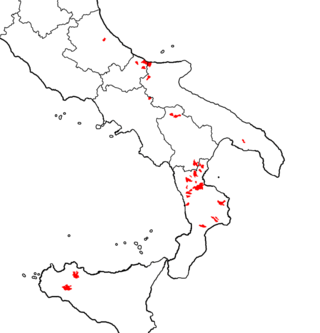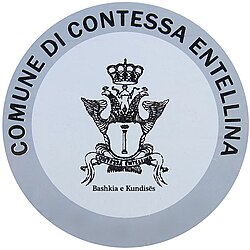
The Arbëreshë, also known as Albanians of Italy or Italo-Albanians, are an Albanian ethnolinguistic group minority historically settled in Southern and Insular Italy.

Giuseppe Schirò was an Arbëresh neo-classical poet, linguist, publicist and folklorist from Sicily. His literary work marked the transition from the Arbëresh language to modern Albanian literature in Italy. He was a major protagonist of the Rilindja, the Albanian cultural awakening or Albanian Renaissance, in Italy.

The Church of St. Mary of the Admiral, also called Martorana, is the seat of the Parish of San Nicolò dei Greci, overlooking the Piazza Bellini, next to the Norman church of San Cataldo and facing the Baroque church of Santa Caterina, in Palermo, Italy.

Palazzo Adriano is a town and comune of Arbëresh origin in the Metropolitan City of Palermo, Sicily, southern Italy.

Piana degli Albanesi, known as Piana dei Greci until 1941, is a town and comune in Sicily, Italy. The town is situated on a mountainous plateau and encircled by high mountains, on the eastern side of the imposing Mount Pizzuta, the city, which is mirrored on a large lake. It is located around 24 kilometres (15 mi) from Palermo and is administered as part of the Metropolitan City of Palermo. In 2018, the comune had a population of 6,128.

Arbëresh are the Albanian linguistic varieties spoken by the Arbëreshë people of Italy, brought there by several migratory waves of Albanians from Albania and Greece since the Late Middle Ages. Arbëresh varieties are derived from the old Tosk Albanian varieties spoken in the south-western Balkans, and throughout the centuries they have developed in Italy in contact with the neighboring Italo-Romance speaking communities. Other Tosk Albanian varieties from the Late Middle Ages referred to as Arvanitika are spoken in Greece by the Arvanites. E Mbësuame e Krështerë (1592) by Luca Matranga from Piana degli Albanesi is the earliest known Old Tosk text, a translation of a catechism book from Latin.

Santa Cristina Gela is an Arbëreshë village in the Metropolitan City of Palermo in Sicily.
Mezzojuso is a comune (municipality) in the Metropolitan City of Palermo in the Italian region Sicily, located about 45 kilometres (28 mi) southeast of Palermo. As of 31 December 2004, it had a population of 3,003 and an area of 49.4 square kilometres (19.1 sq mi).
Giuseppe Schirò Di Maggio, born in 1944, is an Arbëreshë poet and dramatist of Piana degli Albanesi in Sicily.

The Eparchy of Piana degli Albanesi is an eparchy (diocese) of the Italo-Albanian Catholic Church, an Eastern Catholic church sui iuris of Byzantine Rite, covering the island of Sicily in Italy.

Luca Matranga was an Arbëresh writer and Catholic priest of Byzantine rite in the Albanian community of Sicily. He is regarded as one of the most important authors of Old Albanian literature, as his work contains the oldest written text of Albanian in the diaspora.

The Italo-Albanian Catholic Church or Italo-Albanian Byzantine-Catholic Church is one of the 23 Eastern Catholic Churches which, together with the Latin Church, compose the Catholic Church. It is an autonomous (sui juris) particular church in full communion with the Pope of Rome, directly subject to the Roman Dicastery for the Oriental Churches, but which follows the Byzantine Rite, the ritual and spiritual traditions that are common in most of the Eastern Orthodox Church. It uses two liturgical languages: Koine Greek, the traditional language of the Eastern Churches, and Albanian, the native language of most of its adherents.
Giuseppe Schirò (1690–1769) was an Arbëreshë writer of the 18th century, and Catholic priest of the Byzantine Rite. In 1736, he was appointed Byzantine Catholic Archbishop of Durazzo.

Piana degli Albanesi Cathedral, in full the Cathedral of Saint Demetrius the Great Martyr is a cathedral in Piana degli Albanesi, Palermo, Italy. It is the seat of the Eparchy of Piana degli Albanesi, part of the Byzantine Rite Italo-Albanian Catholic Church.
Marco La Piana (1883–1958) was an Italian scholar of Arbëresh origin. La Piana gave his contribute through his studies on Albanian language and Arbëresh dialects.
Leonardo Lala was a writer of Arbëreshë/Albanian origin from Contessa Entellina in Italy and an expert on Arbëresh language, and Arbëreshë history and folk traditions. In 1910 he immigrated to the U.S., where he remained for about three years. Upon his return in 1913 Lala attended elementary school and finished fourth grade and then began to devote himself to farm work, as did most people in Contessa Entellina.

Kristina Gentile Mandala (1856–1919) was an Arbëresh writer from Italy. An early documenter of Arbëreshë fairy tales, she is considered one of the first Albanian women writers.

The Arbëresh Seminary of Palermo, also known as the Italo-Albanian Seminary, was an important educational and cultural center for the Arbëreshë Albanian community in Sicily. The Seminary is situated in the historic center of Palermo, facing the magnificent post office building, between a street of the same name and Piazza Padre Giorgio Guzzetta.

















